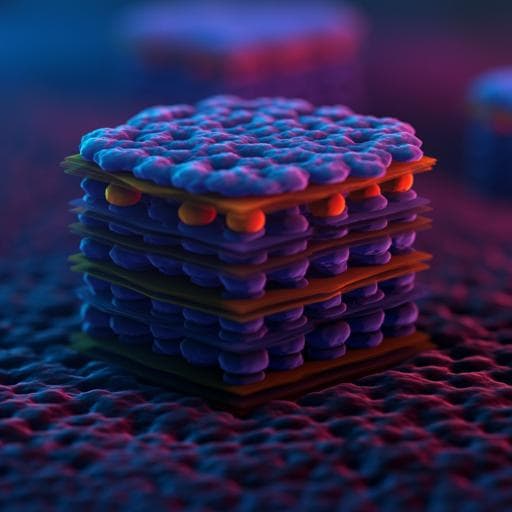
Physics
The composition and structure of the ubiquitous hydrocarbon contamination on van der Waals materials
A. Pálinkás, G. Kálvin, et al.
Explore how the surface environment transforms the behavior of single-layer van der Waals materials like graphene and MoS₂. This groundbreaking research showcases the formation of self-organized molecular layers of alkanes that reshape material interactions. Conducted by prominent researchers including András Pálinkás and György Kálvin.
~3 min • Beginner • English
Introduction
The study addresses the long-standing question of what constitutes the ubiquitous ambient contamination observed on van der Waals (vdW) materials and how it influences their surface properties. Prior reports noted parallel stripe patterns and anisotropic friction domains on materials like graphene, graphite, hBN, and MoS2, but the chemical identity and structure of the contaminant layer remained unclear, with hypotheses ranging from adsorbed gases to strain ripples. The purpose of this work is to determine the composition, structure, formation dynamics, and impact of the ambient adsorbate layer on vdW materials, using surface-sensitive techniques to resolve the molecular identity and organization. Establishing this is important because surface adsorbates can mask intrinsic properties (e.g., wettability and electrochemical activity) and affect fabrication of heterostructures by altering adhesion and interfacial behavior.
Literature Review
Multiple studies over the last decade reported 1D ordered stripes (period ~4–6 nm) and anisotropic friction domains on vdW materials, including graphene (monolayer to few-layer), hBN, MoS2, and WS2. Early explanations proposed self-assembled molecular nitrogen layers; later suggestions included organic chain-like molecules. There was no consensus on the chemical composition or origin. Stripes were observed to align with crystallographic directions, with domains exhibiting 60° reorientations, and friction domains showing C2 symmetry and 60° between adjacent domains. Some works attributed anisotropy to periodic strain ripples, but direct evidence was lacking. The universality across different substrates and environments suggested an extrinsic molecular origin, but identities and structures were unresolved. This work builds on the extensive literature of self-organized monolayers on graphite and temperature-driven phase behavior of alkanes on graphite, using these insights to narrow down possible contaminant families.
Methodology
Sample preparation: Graphite, few-layer graphene, hBN, and MoS2 flakes were mechanically exfoliated onto Si/SiO2. Fresh samples lacked stripes/friction domains; after 4–5 days storage in ambient in clean plastic boxes or Petri dishes, stripes/domains appeared. For spectroscopies, bulk HOPG (1×1×0.1 cm) was cleaved; AFM confirmed contamination prior to IR, STM, XPS.
Artificial monolayers: Dotriacontane (C32H66, 97% purity) was vapor-deposited onto HOPG by heating in a sealed glass Petri dish at 80 °C for 30 min, then cooling in air; glassware pre-cleaned by O/Ar plasma. Arachidic acid (C19H39COOH, ≥99%) was deposited similarly; after heating, the sealed cell was cooled before opening.
AFM: Bruker Multimode 8 AFM in ambient used in PeakForce QNM (PF), contact, and lateral force modes. Scanners: 9159EVLR (15×15 µm) for precise stripe width (calibrated to graphite lattice, ±5% RSD) and 9178JVLR (150×150 µm) for large scans (calibrated to 1×1 µm grid). PF channels extracted: adhesion, deformation, dissipation, Young’s modulus. Tips: Bruker ScanAsyst-Air (nominal radius 2 nm, k=0.4 N/m) for PF; µMasch HQ:NSC19/AI BS (ntr 8 nm, k=0.5 N/m) and Bruker DNP-10 D (ntr 20 nm, k=0.06 N/m) also used for lateral force and domain reshaping. Stripe contrast often stronger in adhesion or modulus channels. Measurements varied scan size, rate, angle, and setpoints to exclude artifacts. Friction domains could be switched by contact mode scanning at sufficient normal load with fast scan parallel to zigzag; patterns stable up to 6 months.
STM: RHK PanScan Freedom in UHV (≤5×10−10 Torr) at 8.9 K and 300 K, with Pt/Ir (90/10) tips calibrated on Au(111). High tunneling resistance (>10 GΩ) required to image molecular adlayer without perturbation; typical imaging at 9 K used 20 pA, 400 mV (~20 GΩ). At lower resistance (e.g., 500 mV, 100 pA), the tip penetrated the adlayer, revealing only noisy graphite lattice. dI/dV obtained using lock-in (10 mV modulation, 1267 Hz); spectra normalized to stabilization conductance.
IR spectroscopy: Grazing-angle reflectance FTIR (Bruker IFS 66/v) at 300 K with Harrick accessory (72° incidence, 6 mm aperture). Up to 6000 scans to improve SNR. Reference spectra from same HOPG after exfoliating the top layers. Baseline correction applied (manual cubic spline) due to instrumental drifts; absorbance A=1−R from corrected reflectance.
XPS: Kratos XSAM 800 with unmonochromatized Al Kα (1486.6 eV), 90° take-off, lens-defined selected-area (~6 mm spot). Data processed with Kratos Vision 2; atomic ratios from integrated peak areas with manufacturer sensitivity factors.
Ellipsometry: Woollam M-2000DI rotating compensator ellipsometer at 60°, 65°, 70° incidence, visible range 450–750 nm. ψ and Δ modeled via two-phase (substrate + Cauchy overlayer). Substrate optical properties from freshly cleaved sample. Reproducibility of ψ better than 0.02; long-run monitoring up to 2 months to follow overlayer growth.
DFT and STM simulations: VASP with PAW method, PBE-GGA with Grimme D2 vdW correction. Modeled short alkanes (C7) on bilayer graphene in rectangular supercells representing edge-on (a=12.3 Å, b=34.08 Å) and flat-on (a=14.76 Å, b=68.17 Å) orientations; 18 Å vacuum. Geometry optimized (forces <0.01 eV/Å), plane-wave cutoff 400 eV, Γ-centered k-mesh 6×2×1 (edge-on) and 6×1×1 (flat-on). STM images simulated by Tersoff-Hamann approximation. Nearest-neighbor alkane-alkane distances adopted from literature: 0.38 nm (edge-on) and 0.45 nm (flat-on). Fourier analysis of simulated images compared with experiment.
Thermal treatments: Annealing at 200 °C for 1 h at ~3×10−2 mbar or under ambient to desorb the molecular overlayer and erase friction domains/stripes; ambient anneal left more residual contamination on surface.
Key Findings
- A self-organized monolayer of airborne contaminants forms on vdW materials (graphene, graphite, hBN, MoS2) after a few days in ambient; it exhibits parallel stripe patterns with period ~3.0–5.2 nm and domain orientations differing by 60°.
- Low-temperature (9 K) STM resolves individual linear molecules arranged side-by-side in stripes; molecules in adjacent stripes are shifted by ~half a molecule width. Stripe width measured by STM: 3.27 ± 0.15 nm, consistent with all-trans alkyl chains of ~C24–C25; AFM stripe widths: 3.4 ± 0.3 nm (graphite) and 3.7 ± 1.0 nm (hBN).
- Room-temperature STM shows a smectic phase, resolving stripes but not individual molecules due to rapid translation along molecular axes.
- Grazing-angle IR spectra of contaminated HOPG show C–H stretching bands at ~2850–2960 cm−1 and a scissoring band at ~1472 cm−1, with no signatures of functional groups (e.g., COOH, OH, halides). Artificially deposited dotriacontane (C32H66) shows identical alkane signatures (with scissoring splitting consistent with thicker crystalline patches). Arachidic acid monolayers display COOH bands absent in airborne contaminant spectra, indicating the natural layer lacks functional groups.
- dI/dV spectra on both contaminant and C32H66 layers show graphite-like V-shaped density of states without molecular resonances, consistent with physisorbed saturated hydrocarbons.
- Fourier analysis of STM images identifies peaks corresponding to inter-molecule spacings (~0.42 nm and ~0.57 nm, arising from hydrogen registry differences) and a quasiperiodic superlattice along stripes (~1.95 nm), observed similarly in both contaminant and C32H66 layers.
- DFT-based STM simulations for edge-on oriented alkanes on graphite reproduce alternating apparent heights (2–3 brighter followed by 1–2 dimmer molecules) and Fourier components (simulated periods ~0.378, 0.485, and 1.13 nm) qualitatively matching experiments. Flat-on simulations do not match observed superlattice, supporting edge-on orientation at low T.
- AFM torsion imaging reveals friction anisotropy domains corresponding to stripe orientations; domains switch by 60° consistent with substrate C3 symmetry (molecules align parallel to zigzag directions; stripes parallel to armchair). Controlled patterning of friction domains achieved by AFM scanning with fast scan along zigzag; patterns stable up to 6 months.
- Formation kinetics: Ellipsometry shows rapid initial adsorption within 40–60 min, but steady-state thickness reached only after ~10–14 days. Proposed replacement of initial mixed adsorbates by longer-chain normal alkanes due to higher adsorption energy per carbon atom; dominant chain lengths C20–C26.
- Heat treatment at 200 °C for 1 h (low pressure or ambient) removes stripes and friction domains by desorption of the molecular adlayer.
- Observations replicated across locations (Hungary, USA, Italy), indicating ubiquity in ambient environments.
- Conclusion: The contaminant is predominantly saturated, linear normal alkanes (C20–C26) forming a self-organized capping monolayer that can displace other airborne species and govern surface interactions of vdW materials.
Discussion
The work resolves the identity and structure of the ubiquitous ambient contamination on vdW materials, attributing the widely observed stripe patterns and anisotropic friction domains to a self-assembled monolayer of mid-length normal alkanes (C20–C26). Atomic-resolution STM, corroborated by IR spectroscopy and dI/dV, establishes the molecular family (saturated linear alkanes), their organization (edge-on, side-by-side in stripes), and the absence of functional groups. Fourier features and DFT-based STM simulations explain the quasiperiodic superlattice and apparent height modulation via molecule–substrate and molecule–molecule interactions. The domain structure and its 60° rotations arise from the C3 symmetry of the substrate’s zigzag axes and provide a natural explanation for easy (zigzag) and hard (armchair) friction directions. Ellipsometry and AFM together suggest a time-dependent replacement of initial mixed adsorbates by longer-chain alkanes, culminating in a stable, ordered capping layer after ~10–14 days. The ability to erase or pattern domains via annealing or AFM provides practical control. The universality across graphene, graphite, hBN, and MoS2 implies that such alkane capping layers are common on hexagonal vdW surfaces and can significantly influence wettability, adhesion, tribology, and interfacial chemistry. These findings enable informed strategies for surface preparation, contamination mitigation, and exploitation of alkane capping in device contexts.
Conclusion
This study identifies and structurally resolves the ubiquitous ambient contamination on vdW materials as a self-organized monolayer of saturated, linear normal alkanes (C20–C26). Using AFM, low-temperature STM, IR spectroscopy, dI/dV, ellipsometry, and DFT-based simulations, the authors show that these molecules form parallel stripe domains aligned with crystallographic directions, underpinning anisotropic friction phenomena. The contamination layer forms over days, displaces other adsorbates, can be patterned or erased, and is stable under UHV. The results unify disparate observations of stripes and friction anisotropy across multiple vdW materials and provide a framework for controlling surface states. Potential future directions include leveraging alkane capping as protective/passivating barriers for air-sensitive 2D materials and transparent gas barriers in conjunction with graphene, and further exploring phase behavior (edge-on vs mixed orientations) and kinetics under varied environmental conditions.
Limitations
- AFM could not capture nucleation or sub-monolayer seeding of the ordered domains during formation; formation was only observed after several days, implying limitations of local probing for dynamic processes.
- STM imaging of the molecular adlayer requires very high tunneling resistance; at typical graphene parameters the tip perturbs/penetrates the layer, limiting room-temperature atomic-scale imaging to smectic stripe resolution.
- DFT modeling used commensurate supercells and short-chain alkanes (C7) with assumed nearest-neighbor distances, leading to quantitative discrepancies in periodicities; simulations qualitatively match but cannot rule out mixed edge-on/flat-on phases.
- Ellipsometry required extensive baseline correction due to instrumental drifts; while trends are robust, absolute thickness determination may carry systematic uncertainties.
- Annealing under ambient removes domains but leaves less clean surfaces compared to low-pressure anneal, complicating post-treatment surface assessment.
Related Publications
Explore these studies to deepen your understanding of the subject.







